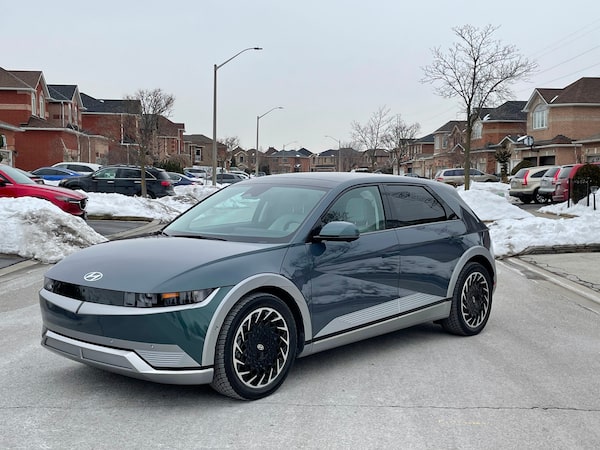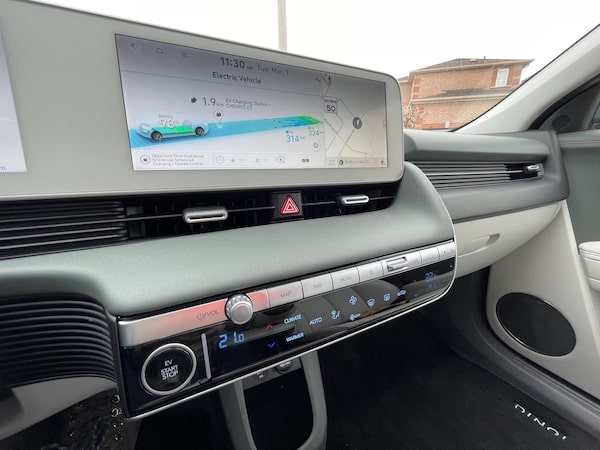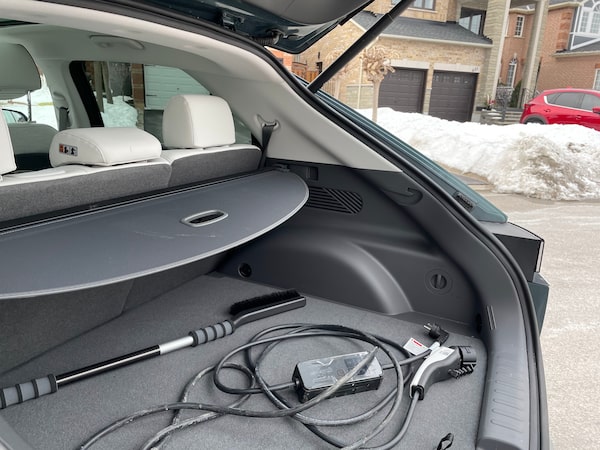
2022 Hyundai Ioniq 5.Matt Bubbers/The Globe and Mail
When bystanders turn to gawk at a car, it’s usually an expensive and impractical one, something low and fast, or regal and gigantic. The Ioniq 5 is none of those things. It’s a $44,999 Hyundai, and yet people are clearly hyped for this all-electric, retro-future wundercar.
A man walking his dog came over to talk about the Ioniq. He knew exactly what it was, and, after some consideration, decided he liked the look of it better than a Tesla.
Opinion: Ontario desperately needs to play catchup on EVs, and jobs are on the line
More surprising was the teenager driving a gnarly vintage SUV with a lift-kit and a loud exhaust, who pulled up beside the Ioniq. I half expected to get “coal-rolled” – to have thick clouds of exhaust fumes shot in my general direction – but nope; he smiled, nodded and gave the Hyundai an enthusiastic thumbs-up.
The Ioniq cuts across all usual car-culture lines. Even my partner, who is usually immune to the charm of new cars, was impressed by the Hyundai’s bright, futuristic cabin. My neighbours wanted to know all about it. I lost count of the number of pedestrians who did double- and triple-takes.

The Ioniq cuts across all usual car-culture lines and features a bright, futuristic cabin.Matt Bubbers/The Globe and Mail
Hyundai Canada noticed plenty of virtual gawking too. In 2020, only one in 10 visitors to the company’s website came for EVs. Last year, following the Ioniq 5′s unveiling, it was one in three.
After a week of living with it, I’m happy and relieved to report that the excitement – including my own – around the Ioniq 5 was justified. It really is, at long last, a cool and (relatively) affordable EV.
But it’s not perfect. The long-range, all-wheel-drive model tips the scales at more than 2,000 kilograms, which is heavy but not unusual for an EV. To hold up all that weight, the car needs stiff springs and dampers, which means the ride can feel firm over smaller ruts and bumps in the city.
On the other hand, over bigger bumps – a curb and ramp into a parking lot, for example – the Hyundai’s suspension is as smooth as butter. Companies like Porsche can get around the need for stiff springs in EVs by using fancy, adaptive air suspension, but that doesn’t come cheap. This may not be the plushest ride in town, but it’s not bad.
It’s worth noting that the fully loaded $54,999 Long Range AWD model with the $5,000 Ultimate package I drove was riding on snazzy 20-inch wheels. The humble 19-inch wheels offer more driving range (around 30 kilometres on the a standardized energy consumption and range test, according to European data) and, perhaps, a marginally cushier ride.
Starting at $45,000 before rebates, the Hyundai Ioniq 5 might be the funkiest, most spacious, most sensible EV purchase this side of a Tesla Model Y.
The Globe and Mail
Other gripes? Cargo space behind the rear seats is a modest 770 litres, because of the unusually high trunk floor (there’s an electric motor under there) and sloping rear window. The Ioniq’s front trunk – yes, there is a “frunk” – only holds 24 litres, barely enough for a charging cable; European cars apparently get a larger frunk that Canadians are sadly denied. For reference, compact conventional SUVs like the Hyundai Tucson and Toyota RAV4 will both haul more than 1,000 litres of stuff in the trunk.
There’s no rear wiper, but the rear-view camera also seems prone to getting covered in road grime and making the view out the back blurry, which is a minor annoyance. As are some of the dated-looking designs on the infotainment screen. The radio display, for example, shows the frequency in a series of vacuum tubes. It’s not in keeping with the futuristic cabin.
Another minor quibble is that the external vehicle-to-load (V2L) adapter – a socket that effectively turns the car into a giant mobile power outlet – is only available as an optional extra. While it’s annoying that most of the high-tech options are only available on the top trim level, it’s hardly surprising.
As far as complaints go, that’s pretty much it actually. None of the above issues should be deal breakers, especially when you consider all the things the Ioniq 5 does so well.

The Ioniq 5 is, at long last, a cool and (relatively) affordable EV.Matt Bubbers/The Globe and Mail
The cabin’s design is refreshing and original, with the feel of a bright, airy greenhouse, especially when fitted with the expensive but gorgeous glass roof. The fact you sit up high will please drivers accustomed to SUVs, and the sheer amount of space in the rear seats feels downright luxurious. It’s like being in a full-size sedan, which is not surprising when you realize the wheelbase is longer than that of Hyundai’s enormous three-row Palisade SUV.
Don’t go in expecting this EV to drive like Volkswagen’s Golf R hot hatchback. The 5 is bigger and heavier, but it’s not boring. Switching into true one-pedal mode makes it super smooth around town, and instant acceleration is always available should you want it.
A friend who’d never driven an EV until this one was left in shock after flooring it for the first time. “It’s dizzying,” he said, still coming down from the adrenalin rush. On winter tires at least, there’s enough torque to push the rear wheels into a little slide if you’re not careful.
If that’s too much excitement for you, the car can play soothing ambient sounds, which I initially dismissed as a gimmick. The busy café noise is awful and the ocean sounds make it feel like you’re underwater, but the forest soundtrack with wind rustling in the trees was absolutely serene. You couldn’t have road rage in that.

The trunk on the 2022 Hyundai Ioniq 5 has cargo space behind the rear seats for a modest 770-litres.Matt Bubbers/The Globe and Mail
In terms of price and driving range, the Hyundai is right at the sweet spot for EVs in 2022, especially because it qualifies for the $5,000 federal rebate on zero-emissions vehicles.
During a week of sub-zero temperatures, the long-range, all-wheel drive model riding on 20-inch wheels was on pace to cover 320 kilometres on a single charge, which is admittedly much less than its 414-kilometre rating. (My driving was, perhaps, a bit too exuberant. I also didn’t plug the car in overnight.)
As tested, this fully loaded car was priced at $60,199, before the rebate, which is a lot; I’d opt for the $51,999 long-range rear-wheel-drive model, rated for 488 kilometres.
It’s impressive when you consider Tesla’s Model Y now costs an eye-popping $78,990, and offers 512 kilometres of range. With 350-kilowatt DC fast-charging capability, the Ioniq is ready to take advantage of speedy Level 3 chargers, if you can find one.
The bottom line is that if I were in the market for an EV today, I’d buy the Ioniq 5, no doubt. You lose out on Tesla’s Supercharger network, but after recent steep price increases, it’s becoming harder to recommend the Model 3 or Y. The Hyundai is a rare car that is worthy of the hype. Its combination of original design, beautiful cabin and a strong price-to-driving-range ratio make it an easy choice for me. For those looking to make the switch, this would be an excellent first electric vehicle too.
The only real problem might be finding one, and then getting a dealer to sell it without a ridiculous markup. Hyundai Canada received more than 4,000 preorders last year, and has so far delivered only 1,500 of them. If you place an order now, expect to take delivery in late 2022, a spokesperson for the company said. And I’m betting that’s a best-case scenario.

The only real problem with the Ioniq 5 might be finding one, and then getting a dealer to sell it without a ridiculous markup.Matt Bubbers/The Globe and Mail
Shopping for a new car? Check out the new Globe Drive Build and Price Tool to see the latest discounts, rebates and rates on new cars, trucks and SUVs. Click here to get your price.
James Engelsman and Thomas Holland from Throttle House compare Kia’s new EV6 electric vehicle against it’s retro-looking cousin, the Hyundai Ioniq 5 to see which is the better daily driver.
The Globe and Mail
 Matt Bubbers
Matt Bubbers